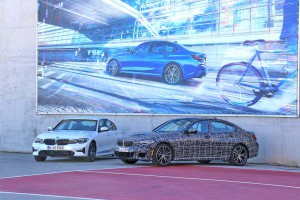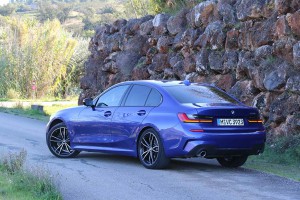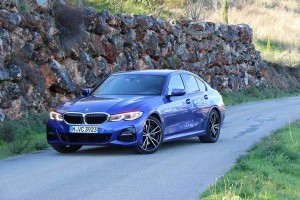
BMW's taking the covers off the next-gen 3-Series. The 330i is certainly a step above its predecessors.
There are advantages to being the best in breed – but there are some disadvantages, as well, as BMW is well aware. Since the very first version rolled out in May 1975, the BMW 3-Series has been the benchmark of the compact sports sedan market, delivering a mix of performance, handling and luxury that other brands have struggled to match.
Now, however, as the seventh-generation 3-Series gets ready to roll into showrooms, the Bavarian automaker faces a level of competition never seen before. Traditional rivals like Mercedes-Benz and Audi have been zeroing in on the BMW formula, as have new competitors such as Genesis, which recently won high-profile kudos like the Motor Trend Car of the Year.
And Tesla is aiming to redefine the rules with its all-electric Model 3. BMW is even competing with itself. In an SUV-crazed world, more and more traditional 3-Series buyers have been migrating to the brand’s own X3 crossover.
In other words, the all-new, seventh-generation 3-Series faces a level of uncertainty not seen since the original model, internally codenamed the E21, debuted more than four decades ago. To see if it lives up to expectations, TheDetroitBureau.com caught a flight to the Algarve, a mountainous region along Portugal’s southwestern coast. Its winding roads, fast freeways – and one of Western Europe’s more challenging, Formula 1-rated tracks – gave us ample opportunity to see if the new 3-Series lives up to expectations.
To be blunt, the outgoing version of the sedan fell short, losing a bit of the crisp driving dynamics that have long defined the BMW brand. The 2019 remake, codenamed G20, not only had to correct those shortfalls but take things to a new level to acknowledge what all those competitors are up to. That includes not only better performance and handling but improvements in design and refinement. And while ride and handling might define the breed, the reality is that today’s customers will be demanding a new level of sophistication when it comes to high-tech safety and infotainment technology.
(BMW offered up a “first look” at the new M340i and M340i xDrive. Click Here for the story.)
So, how did the 2019 BMW 330i and 340i models stack up?
Visually, the new 3-Series is one of the most handsome models in the BMW line-up. It’s not a complete break from the past, the new sedan maintaining classic sporty rear-drive proportions. But the team led by the brand’s design director Adrian van Hooeydonk reduced the number of lines and creases that carved up the old car’s sheet metal. The result is a vehicle that is it both cleaner and yet more sophisticated.
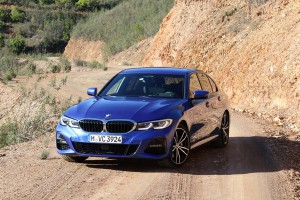
The new 3-Series is more evolution than revolution as it carries over many of the exterior design cues, but features a rounder shape overall.
The overall stance is lower and wider, giving it a more muscular and emotional appearance. That’s enhanced by the quad headlights framed by L-shaped running lights and a squatter and more three-dimensional version of the trademark double-kidney grille. Those headlights, incidentally, can be either LED of laser, the latter technology stretching roughly a third of a mile ahead but able to automatically shift to prevent blinding oncoming drivers The good news is that laser lamps have finally been approved by NHTSA, but the downside is that they’ve been detuned for the U.S. market, meaner a shorter reach down the road.
The lower portion of the sedan’s face contains a newly designed version of BMW’s now-familiar air breather duct. The approach increases the amount of air that flows into the front wheel well. This serves two purposes, both reducing aerodynamic turbulence while also better cooling the brakes. That was a welcome improvement as we discovered during some insanely fast laps chasing former BMW Formula One driver Timo Glock around the Autodromo Algarve Internationale track.
As has happened with virtually every prior edition of the 3-Series the 2019 makeover grows larger in most key dimensions. It’s 3 inches longer overall, the wheelbase growing about 1.6 inches. The front track is 1.7 inches wider, the rear by about 0.8 inches. The new sedan does sit lower, with its center of gravity dropping by about 0.4 inches, and despite the overall increase in size it is as much as 121 pounds lighter, depending upon the model.
Inside, the new 3-Series makes some critical improvements. As with the exterior design, one of the goals was to make the cabin both simpler and more elegant. The horizontally oriented instrument panel flows into doors which have far fewer frou-frou details. The look is definitely a step up, though still not quite on a par with what Audi is doing, the Volkswagen luxury brand continuing to set the benchmark for interior design.
Still, BMW does accomplish some impressive detailing, including what it claims is the world’s first use of curved glass on the instrument panel over the wider, and lowered, touchscreen display. The infotainment system introduces an entirely new user interface that allows for a wide varieties of input, including the familiar iDrive knob, steering wheel buttons, touch and gesture control. But you also get the new BMW voice assistant that is, for all intents, a mobile take on Amazon’s Alexa.
Want to change radio stations, adjust the temperature or plug in an address, the system will do that and more when you say, “Hey, BMW.” You can also give the British female-voiced system any name you desire, unlike Alexa. We’ll not repeat here some of the selections our creative colleagues came up with.
There are, as one would expect, a wide range of digital technologies introduced on the new 3-Series, including a virtually hands-free system for dealing with low-speed traffic situations. One of the more intriguing features is the back-up assistant that, whenever you’re creeping along at parking lot speeds, remembers the last 150 meters, or about 500 feet, that you’ve driven. Discover you’ve hit a dead end and dread having to weave back out around a variety of obstacles? No problem. Tap a button on the touchscreen and the car will do it for you as long as you operate throttle and brake.
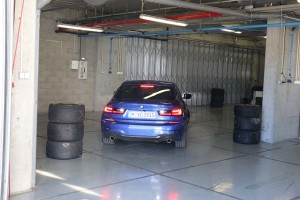
The new backup assistant on the 330i retains a memory of the last 500 feet driven, and can tackle it in reverse in the event turning around isn't possible.
Another new feature allows you to skip carrying a conventional key or fob, using a smartphone app, instead. And you can share that virtual key with up to five other people.
The main gauge cluster also goes digital, with one of the best 3D virtual renderings we’ve seen. It’s reconfigurable, so you have a variety of options to choose from as you switch through driving modes that range from comfort to sport plus. Those drive modes adjust a variety of different vehicle functions, incidentally, including throttle and transmission response.
(Click Here for a first look at BMW’s new 8-Series convertible.)
The 2019 BMW 3-Series will be offered with somewhere on the order of 14 different powertrain options globally. For the U.S. market, however, it will launch with two engine packages, each with either rear- or all-wheel-drive options. A third, a plug-in hybrid, will launch next spring.
The base engine is the turbo four in the 2019 BMW 330i. It punches out a nice 255 horsepower and 295 pound-feet of torque, an increase of 7 and 37, respectively. The sportier 340i, with its inline-six, bumps that up to 382 hp, a whopping 62 ponies more than before, with torque climbing 39 lb-ft, to 369.

The base engine in the 330i is a turbocharged four cylinder putting out 255 horsepower and 295 pound-feet of torque, an increase of 7 and 37, respectively.
While BMW is still calibrating the hybrid, it uses the same inline-four, with its twin-scroll turbo, as the 330i. It can run in all-electric mode at speeds up to 140 kmh, or nearly 90 mph, and it’s expected to hit 60 in six seconds or less. There’s also an “extra boost” mode that will punch out an extra 30 kilowatts of power for a tire-spinning launch if you don’t mind cutting your all-electric range.
The two conventional engine packages features a new aluminum rear differential, though you can get the optional sport package for the 340i that includes both sport steering and an M Sports differential. Both engines are paired with an eight-speed automatic, though the sport package is M-tuned.
BMW officials stressed that they had two potentially conflicting targets for the next-generation 3-Series, including both better performance and improved fuel economy. We’ll have to wait for final mileage numbers but the automaker claims it hit both targets. You can certainly feel the added horsepower and torque when you get on the road.
Even the 330i offers solid acceleration with essentially no sense of turbo lag, thanks to the twin-scroll design. We spent nearly two days wandering through the Algarve in the entry U.S. model and found it to have rediscovered the sense of dynamic driving that one would expect of the 3-Series. Bavarian aficionados know that is a combination of good acceleration, precise steering and solid handling.
The revised steering system provides just the right amount of boost and road feel without being jarring. The new car benefits from a stiffer suspension and damping system – with newly designed hydraulic stop damping shocks that can swallow up even hard bumps without sacrificing handling.
You notice this even more with the 2019 340i. We headed out onto the nearly four-mile Algarve track and immediately dialed things up to 11. With many competitive vehicles that would have been a recipe for panic and potential disaster. The 340i proved almost uncanny in its ability to road manners. It proved surprisingly forgiving as we learned away around the complex track, allowing us to recover from a misplaced corner apex, while gaining speed on each successive lap. It is the kind of sports sedan that lets even an amateur driver feel like they’re pushing into pro territory.
On public roads, both versions of the new 3-Series proved a sheer joy to drive, inspiring confidence while pushing the limits, yet providing surprisingly comfortable under less aggressive driving.
What may be equally impressive, however, is BMW’s decision to rein in pricing on the 2019 3-Series line-up. Recognizing the competitive set it is going up against, the “base” 2019 BMW 330i starts at $40,250, plus $995 destination fees. The 340i which, for some reason, is being designated a 2020 model starts at $54,000. The 330i xDrive comes in at $56,000 plus delivery fees.
In a different environment we’d expect to see BMW overwhelm all comers. But it’s a different world from the one the Bavarians long dominated. There are not just more competitors but some truly breakthrough alternatives, such as Tesla’s Model 3. And then there’s that massive shift from passenger cars to light trucks that makes the BMW X3 one of the 3-er’s toughest competitors.
(First official look: new BMW SUV flagship. Click Here for more on the new X7.)
But for those who see the 3-Series as the definition of the “ultimate driving machine,” BMW has made up for the sins of the outgoing model. The 2019 BMW 330i and 2020 340i again set the benchmark by which compact sports sedans are judged.

